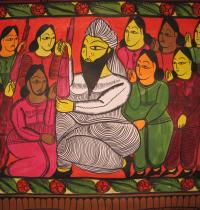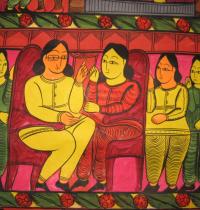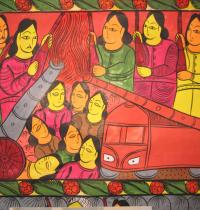Roma Chatterji
Grant Period: Over one year
Roma Chatterji is a Reader at the Department of Sociology, Delhi School of Economics, and has a PhD in folklore. For her doctoral thesis she studied folklore and the popular consciousness in West Bengal. Her writings and research work have appeared in academic journals and have been presented in seminars. In this research project she will explore how the growing markets for tribal and folk art influence its aesthetics and style.
Her proposal states that “the engagement of the folk and tribal arts with recent political events and with new artistic media like paper and acrylic paint, and an easy access to urban consumers facilitated by state sponsored ventures such as Dilli Haat and the Crafts Museum in Delhi has led to the emergence of a market for the ethnic arts”. Though the ‘commodification’ of these art forms has been studied, there as been little ethnographic work carried out on the actual process by which this market inflects these art works in terms of aesthetic style, subject matter and scale of composition. Dr Chatterjee will explore the ‘commodification’ of the folk arts as a social process. She will systematically map the actual networks within which such art commodities circulate, and the aesthetic developments in the visual field. She will also study the resources that are built up in the process and how the overlapping networks of domestic and market production give rise to new aesthetic issues regarding style and regional identity.
Roma proposes to systematically study and compare the Pata Chitra of Bengal and the Gond style of Madhya Pradesh as an ‘emergent’ phenomenon, rather than as ‘frozen’ traditions. These forms have been chosen because of the influence that state intervention has had on them. For example, the Gond art of Madhya Pradesh, though rooted in the local narrative tradition for centuries, emerged as an ‘art form’ only around three decades ago. The art of the Patuas, for instance, has been used in AIDS awareness and Pulse Polio campaigns. The other reason why she has chosen these two forms is the contrasting institutions within which these forms are now embedded. The Patuas continue to be bound by their traditional narrative and musical style even though they have expanded their repertoire. On the other hand, the Gonds have largely given up their traditional occupation as bards, and their paintings are rarely based on specific narratives in their own story-telling tradition. There is, therefore, scope here to explore the different nature of their evolution.
Roma points out that the most significant aspect of folk art is that it is now marked by a self-reflexivity and a self-conscious stance towards tradition and society, and these artists are now seeing themselves as part of a larger pictorial field in which images produced by other kinds of media also inform their visual and narrative world. Folk art forms are thus ‘double’ located––in the past and in the continuous tradition, and also in the contemporary world. They are, therefore, ideally suited for a study of the making of cultural traditions.




